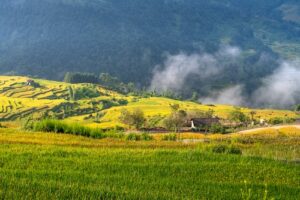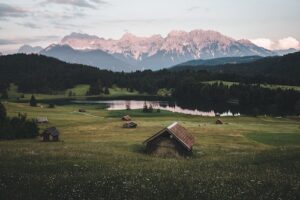Urban landscape refers to an outdoor environment that is dominated by and influenced by urban features. This includes both man-made and natural elements found in an urban area such as buildings, roadways, parks, and other elements that are present in a city or town. An urban landscape is made up of a variety of different elements and it is constantly changing to accommodate the needs of the community.
Urban landscapes are highly varied and can take on many different forms. For example, some urban landscapes may include modern architecture and high rise buildings, while others may focus on green spaces and parks. Other urban landscapes may include historic architecture and monuments, bustling sidewalk cafes, and vibrant public art displays.
The type of urban landscape depends on the city or town that it is located in and the amount of space that is available. For some cities, the urban landscape may be dominated by skyscrapers and other large buildings, while in other places, the urban landscape is made up of small shops and residential areas. In all cases, the urban landscape serves an important role in the city and its inhabitants.
The Components of an Urban Landscape
Urban landscapes typically comprise of four components including the built environment, public spaces, natural resources, and human activities.
Built Environment
The built environment is composed of the physical elements that make up an urban landscape. This includes handmade structures such as buildings, roads, and bridges, as well as infrastructure such as sewers and power lines. The built environment also encompasses the design elements of an urban landscape; the different shapes and sizes of buildings, the type of street furniture or décor, or the placement of public art.
The design of the built environment influences the feel and character of an urban landscape. The design of an urban landscape is shaped through the intentional or unintentional choices of architects, planners, and policy-makers.
Public Spaces
Public spaces are the outdoor areas that are accessible for use by the public; parks, plazas, streets, and sidewalks. These spaces have a variety of uses and can be used for recreational activities, as a gathering place for people, or as a site for special events. Public spaces are important to the urban landscape because they provide people with an area to relax, contemplate, and interact with others. Public spaces are also important because they can help to promote social cohesion in cities.
Natural Resources
Natural resources are an important part of any urban landscape and can include rivers, lakes, wetlands, forests, and plant and wildlife species. Natural resources provide essential services to people; such as clean air, clean water, and places for recreation. Natural resources also provide benefits to urban landscapes by providing a source of beauty and enhancing the overall livability of cities.
Human Activities
Human activities can have both a positive and negative impact on an urban landscape. Human activities including transportation, industry, and commerce are necessary for cities to function and survive, but can also create pollution, congestion, and other imbalances in the environment. At the same time, human activities can also have positive impacts on cities; such as providing employment, stimulating economic growth, and adding to the aesthetic beauty of cities.
The Impact of Urban Landscapes on Cities
Urban landscapes play an important role in cities and the lives of their inhabitants. An urban landscape can influence city life in several ways; by promoting physical health, improving mental health, and adding to the aesthetic beauty of a city.
Urban landscapes also play a key role in sustainable cities and the environment. Sustainable urban landscapes are designed to be resource-efficient, prevent or reduce pollution and conserve natural resources. Sustainable urban landscapes also help to strengthen local communities, create green jobs and reduce emissions from transportation and industry.
Watch this video:
Conclusion
Urban landscapes are an important part of cities and contribute to the livability, sustainability and vibrancy of cities. Urban landscapes are composed of a variety of elements, including the built environment, public spaces, natural resources, and human activities and these elements have a significant impact on the lives of city inhabitants. Urban landscapes play a key role in promoting physical health, mental health, and environmental sustainability, and creating green jobs and economic prosperity. Urban landscapes are constantly changing and respond to the needs of city inhabitants and the environment.



